Microsoft, Twitter, Facebook, Amazon, Paypal, Google, LinkedIn, etc. Each of these tech companies has chosen to install its European headquarters or at least major offices in Dublin. The U.S. giants, lured by a very advantageous and very controversial tax policy, have left their marks on the fabric of the city. They came with jobs of course but also with hideous office buildings, energy–hungry data centers, rampant gentrification and rents Dubliners can no longer afford.
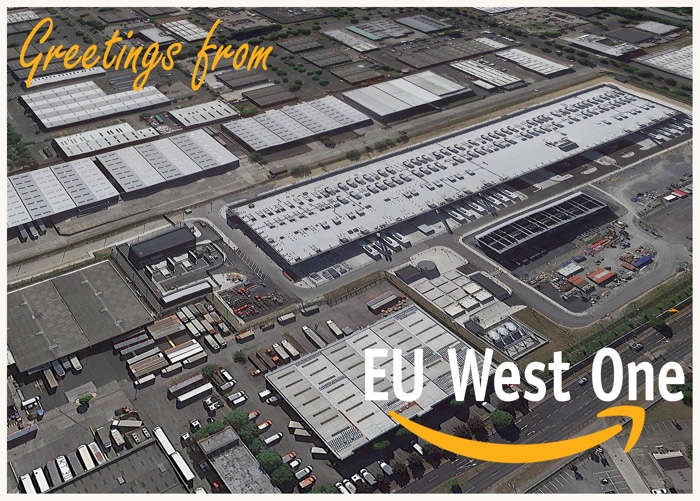
Photo credit: Paul O’ Neill
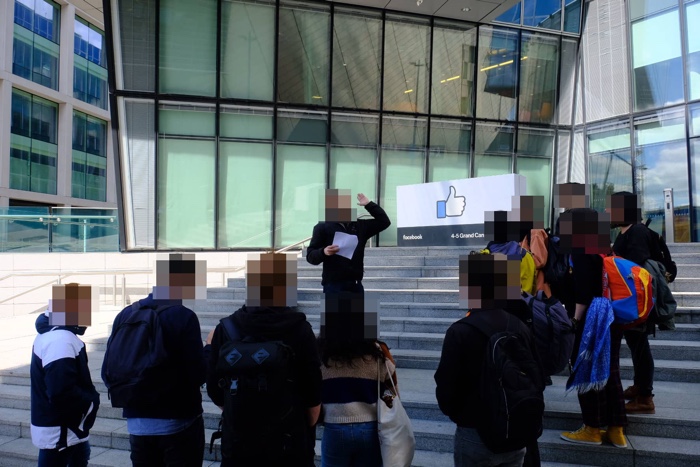
A tour of the Internet’s physical infrastructure in Dublin with Paul O’Neill. Photo credit: Harikrishnan Sasikumar
All these issues are regularly discussed in the national press of course but researcher, artist and activist Paul O’Neill wants to expand the IT debate to the wider geography of tech infrastructures. A few months ago, he started taking Dubliners and curious tourists on a guided tour of the headquarters, warehouses, data centers and other infrastructures the internet relies on.
His objective is to bring to light the kind of influence and power that hide behind the sheer banality of corporate architecture and manhole covers.
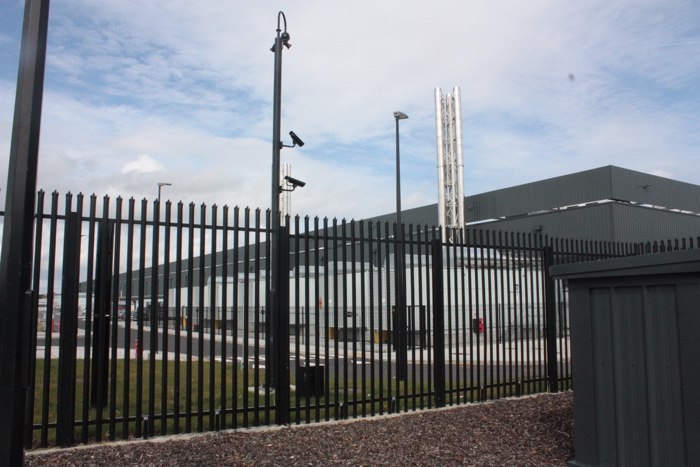
Photo credit: Paul O’ Neill
I’ve met O’Neill twice. The first time was during an online workshop with the School of Machines, Making & Make-Believe. The second time was a few months ago when we were both in France for Nø School Nevers. That’s when i realised he was the guy a few friends of mine had told me about: the academic and artist who walked through industrial estates, Silicon Docks and availability zones with anyone wondering what the internet was made of. By the time i had realised what his research was about, it was already 2pm and i had to run to the train station. So i caught up online with him and interviewed him about his guided tours:
Hi Paul! You organise tours that uncover the physical infrastructure of the internet in Dublin. What got you interested in the topic?
For the last few years I have been interested in doing a project on the many big tech companies based here. I felt that there wasn’t too much critical reflection in Ireland connecting the actions and impacts of these companies internationally with their corporate offices in Dublin. Last year I attended Freeport, a summer school in Barcelona, organised by Bani Brusadin and led by the Share Lab. This programme detailed many different methodologies including the analysis of national Internet Protocol (IP) addresses and ranges. When I came back to Dublin I started looking at IP addresses for Ireland. I found that just under 33% of all Irish IPv4 addresses here were registered to Amazon. This compelled me to look at the operations of Amazon, in particular their cloud computing subsidiary Amazon Web Services (AWS). The reason for the high percentage of Amazon IP addresses was because of AWS data centres. Ireland is an AWS region (EU-West-1) and has at the moment approximately 8 data centres surrounding Dublin city.
At the same time that I was doing this research on AWS, I was also reading Ingrid Burrington’s Networks of New York: An illustrated field guide to urban internet infrastructure. Using this book, I began to search for traces of the physical internet within Dublin city centre. Through this process I was able to map the cellular towers in the city, as well as some of the fibre optic cables running under the streets – alongside the companies who owned or controlled them. The next step was to try to connect the physical internet infrastructure within Ireland to the rest of the world. To do this I started looking at the subsea cables that land here.
I was trying to figure out different ways, outside of ‘traditional’ academic and artistic settings, of disseminating all the information I had gathered. Taking inspiration from Spanish artist Mario Santamaria’s brilliant Internet Tours, I decided that this participatory tour approach would be the best way to not only share my research, but also to facilitate conversations surrounding the physical infrastructures and the different sites of power that they connect with and run through – be that a data centre in an industrial estate in the suburbs of Dublin, or in the corporate offices within the city centre.
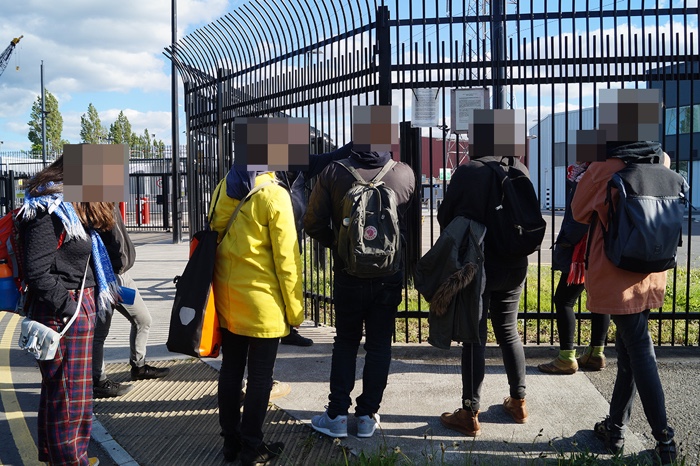
A tour of the Internet’s physical infrastructure in Dublin with Paul O’Neill. Photo credit: Èrika Marcet
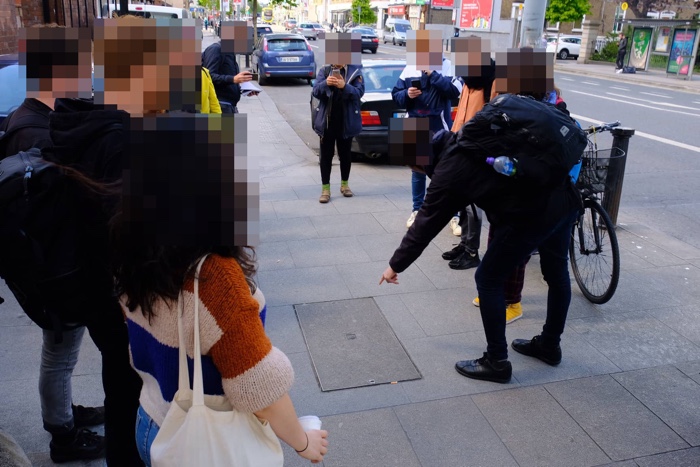
A tour of the Internet’s physical infrastructure in Dublin with Paul O’Neill. Photo credit: Harikrishnan Sasikumar
What is the most surprising things you discovered while researching the presence of the world’s largest technology companies in your own city?
I guess what surprised me most was what I already knew. Dublin, and Ireland, is a significant part of the internet’s physical and corporate infrastructure. AWS is not the only large tech company with a large physical infrastructural presence in Ireland. Google, Facebook and Microsoft also operate data centres here. This is on top of their corporate interests. Google and Facebook’s European, Middle East and Africa (EMEA) headquarters are here, whilst Amazon and Microsoft have significant corporate operations. Most of these companies, alongside Twitter, Airbnb and Linkedin (all with EMEAs in Dublin) are all concentrated within close proximity to each other, in an area now referred to as Silicon Docks.
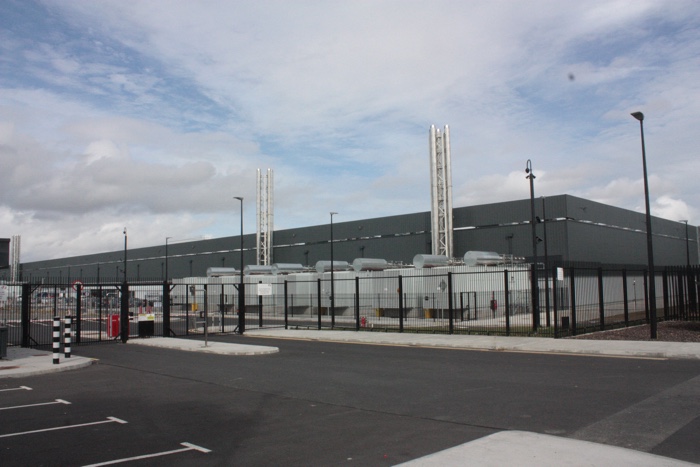
Photo credit: Paul O’ Neill
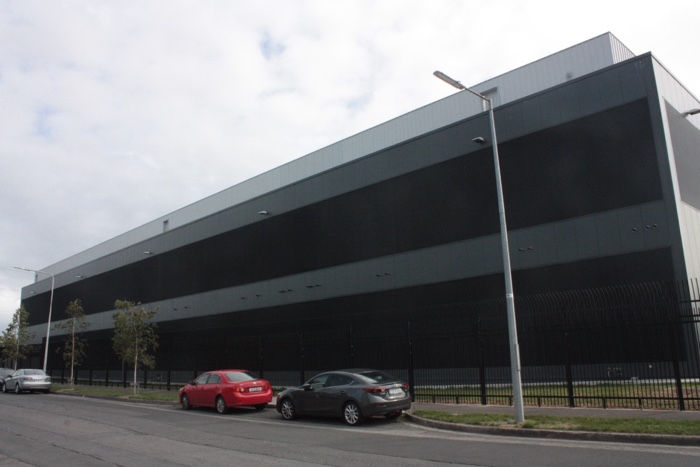
Photo credit: Paul O’ Neill
What kind of people are interested in the tours?
So far I have only done two full tours (they last 6 hours and take quiet a bit of preparation). The first iteration was for a group of artists, academics and activists, the second was for students from the School of Machines, Making and Make-Believe who were in Ireland as part of the Future Landscapes programme in NUI Galway. However, I’ve led a few mini-tours where people have heard about the project and got in touch. This has been a great opportunity for me to connect with others doing similar research here – I’ve learnt a lot from them and I’ll be incorporating their insights into further iterations of the tour. I’ve had other people contacting me from diverse professional backgrounds, everything from network engineers to actual ‘real’ tour guides, as well as interest from mainstream media – which was weird! Hopefully I’ll be able to get the engineers and ‘real’ tour guides on the next one, not as participants but as guest speakers/guides.
I am very eager to include other people’s expertise and personal experiences within the project. The last tour featured two guest speakers. The first guest, Ceilim Robinson, is a student and artist who grew up in Ringsend, a neighbourhood next to ‘Silicon Docks’. Ceilim spoke about his experiences of growing up in this area and how as a result of the tech companies moving into the area and the subsequent gentrification, he will never be able to buy a house in the neighbourhood his family have lived in for generations. Ceilim’s presentation was delivered outside of AirBnB’s headquarters. The second guest was Patrick Brodie, a PhD researcher based in Concordia University in Montreal. Patrick gave a fascinating overview of the history and development of the data centre industry in Ireland within the context of post-industrial society’s production centres alongside Ireland’s path to globalization. The participatory aspect of the project is important.
We are all, whether we choose to be or not, part of this ‘networked’ world, therefore we all have a part in its story. We can all be tour guides, and maybe in doing so we can take control of a narrative that is constantly framed within the context of ‘progress’, without too much reflection on the cost or consequences of this progress.
Would you say that you are reaching the audience you’re aiming for?
Yes and no. As you would expect, most of the people who have participated in or got in touch all have an interest or are involved in some aspect of digital culture. However, I’d really like to have people who may not have too much prior knowledge or awareness of the issues raised in the tour. I’d love to hear their insights and perspectives, whilst also hopefully demystifying both the language and physical infrastructures of tech, by literally pointing to, as Lisa Parks puts it, the ‘stuff we can kick’.
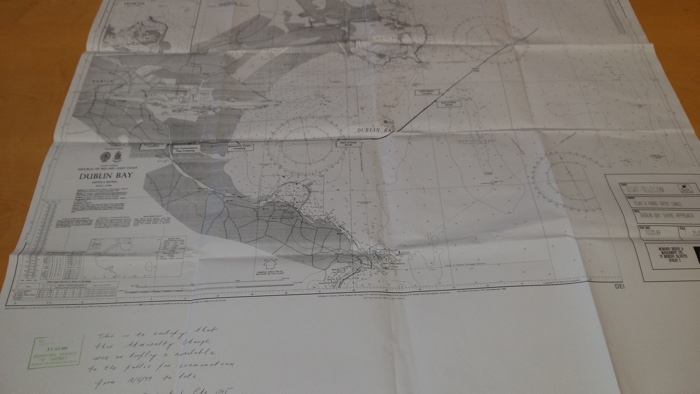
Photo credit: Paul O’ Neill
Where do you find all the data and information about the location, ownership and function of this infrastructure? Do you use wikileaks, pour through publicly available information, collaborate with other experts? Have you ever tried to contact these companies?
Let’s start with the IP addresses I mentioned earlier. I was able to determine this information using various IP geolocation websites, all free and accessible to anybody with a laptop and internet access. Although WikiLeaks released a document late last year detailing AWS data centres around the world, I had already found the ones in Dublin, although this was a little bit tricky at first. They were mentioned in national and local media but specific addresses were a little vague. I found the exact locations by looking through planning permission applications on various city council websites although even that was a little difficult. I was searching these sites using the terms ‘Amazon’, ’Amazon Web Services’ and/or ‘AWS’. However, many of the actual planning applications were made using the acronym ADSIL (Amazon Data Services Ireland Limited), once I figured that out, I could access the planning permission documents of AWS.
I was able to map various infrastructures within the city centre using publicly available data found online such as the Irish Commission for Communications Regulation website. This site provides the location of all the cellular towers in the country, who is using them, and for what. Tracing fibre optics beneath the streets was more problematic. I did a lot of walking, looking at/for manhole covers branded with particular company names and logos. I then put in an FOI request which helped me to get some (but not all) of the information I needed. To identify the various subsea cables landing in Ireland, I used online sources and also checked foreshore licences, which are similar to planning permission documents and are issued to subsea cable operators by the Department of Housing, Planning and Local Government.
Overall, most of the information used in the tour was available online. Obviously every country is going to be different in terms of transparency, but you can really achieve a lot with a laptop, connectivity and of course time, which not everybody has unfortunately. The hardest part of the research process was collating everything into a coherent narrative that not only engages and entertains the audience, but also clearly links the technical with the social, historical and political dimensions of communications infrastructure(s).
Apart from approaching AWS for comment for an article I wrote for the Dublin InQuirer, I haven’t contacted any of the companies mentioned above. This may sound naive, but I like the idea of the tour as being a ‘people’s tour’. I’m pretty sure any contact with these companies would just result in them coming out with some sort of PR glossy sound bite. At the same, there is a need for dialogue with these companies… but that’s a job for somebody else!
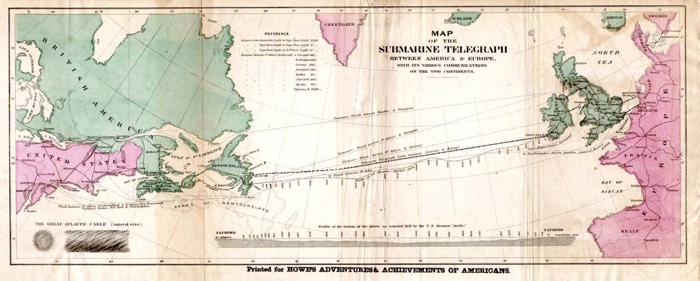
Map of the 1858 trans-Atlantic cable route (Unknown – Howe’s Adventures & Achievements of Americans)
You mostly do tours in Dublin, right? Do you know if similar situations can be observed in the rest of the Republic of Ireland? In Northern Ireland? Or is there something special about Dublin?
The tour is obviously very Dublin centric as I live and work here. There are of course plenty of other tech related stories around Ireland. For example, Apple has been based in Cork since 1980. Last year it cancelled plans to build a data centre in Galway following numerous planning permission objections and challenges. Apple, alongside the Irish State, are also currently involved in a battle with the EU over a 13 billion euro tax bill.
In terms of more physical infrastructure like subsea cables, that’s even more rich in terms of history. The first transatlantic subsea cable dates back to 1858 and stretched between Valentia Island off the southwest coast of Ireland to Newfoundland in Canada. A consortium of companies, including Facebook and Google, are currently developing a new subsea cable on the west coast, which I assume will connect to their data centres in Dublin. I’m a little bit unsure of the North’s infrastructure to be honest. There are approximately 7 subsea cables connecting it directly to different parts of the UK and to the US. Although Dublin centric, I do include all of the above, and more, within the tour. I guess the ‘special’ thing about Dublin is not only the concentration of tech companies in one specific area, but the proximity of these corporate-tech sites of power to data centres, another critical infrastructural and site of power. Dublin is a small city, you can travel from the Silicon Docks area to many of these data centres in about 40 minutes using public transport.
I’m particularly curious about the cables. How easy is it to just go to the location where they emerge from the sea? Can you actually see something? Or are they all well hidden or maybe protected with care?
I’ve been caught! I spent a couple of days aimlessly wandering around Sandymount, a coastal area just outside the city centre, looking for a specific cable but couldn’t find any traces of it. This was at the early stages of my research. I’m pretty sure with all the information I’ve collected now such as admiralty charts and foreshore licenses ,I could probably find it and others. I did discover some online blogs/communities with people who were documenting different landing points, mostly in the UK. You probably know these already, but I would point your readers in the direction of artists such as Evan Roth and Femke Herregraven, or more academically, Nicole Starosielski, who have all done a lot more detailed research on subsea cables around the world. For the current version of tour, the specific location of them is not really necessary as the focus is more on data centres and corporate HQs, but maybe in future iterations…
One of the texts you wrote for Dublin Inquirer mentions that the Snowden documents “revealed that British intelligence, specifically GCHQ, had been targeting subsea telecommunications cables, including some with landing points in Ireland.” Maybe my question is a bit naive or stupid but could Brexit have any impact on the way this infrastructure (cables or others) can be accessed and used for surveillance?
Tricky question. My understanding is that if any state wants to access these cables, and have the means to do so, they will. Despite the horror show that is Brexit, I assume countries (and corporations) will still work together – and against each other- in terms of surveillance and monitoring, whenever it suits them. What I do think is interesting in relation to Brexit is the possibility of infrastructural routes being altered. At the moment, there is one subsea cable under development that will connect Ireland directly to France. This is not as a result of Brexit, but I do find it interesting. In the future will latency be sacrificed for geopolitics? Probably not, as latency, in my understanding, is ultimately all about financial gain.
How specific is Ireland, and Dublin in particular, compared to the rest of Europe, when it comes to facilitating the operations of the GAFA and turning a blind eye to its most opaque practices?
I’m slightly wary of discussing other European countries as I haven’t done much in the way of comparative research. As for Ireland, obviously we’ve been consistently aggressive in terms of attracting foreign direct investment through our corporate tax regime. It makes economic sense to have all of these companies here and does much to elevate Ireland as a ‘player’ in the international corporate tech environment. My take is that the Irish government are a little out of their depth in relation to the bigger issues surrounding these companies and seem to be too eager to please. As a result of GDPR and with so many of these companies having their EMEA HQs here, I imagine Ireland will increasingly be a focus point for all kinds of data/tech related issues, yet I’m not convinced that this has been given any sort of serious consideration in relation to potential long term implications and responsibilities. We do have an unfortunate and horrible history of turning a blind eye to the actions of powerful transnational organisations here…
What is next for your research? A book would be nice… Or maybe a map?
It all comes down to time. A book and/or a map would be great and is something I have considered. From a more short term perspective, I need to get all of the information I have collected online in some sort of open navigable way. As I mentioned earlier, I’m very interested in other people contributing to the project. It would be great if people started doing their own tours using some of my research but building on it based on their own research and experiences. There are so many stories in all of this, not just the big data/tech headline grabbing stuff, but also the perspectives of people who just engage at the interface level, or the workers who lay the fibre optics cables around the country, the people working in the phone repair shops and so on. I like the idea of a people’s history of the internet, or something like that. All of this is in the hope that we can generate a bit more understanding amongst ourselves surrounding all of these corporate-tech debates and controversies, and through this process of peer learning, make these companies more visible, transparent and answerable to us.
Thanks Paul!
Paul O’ Neill is a PhD researcher based in the School of Communications in Dublin City University. His research focuses on tactical media, media archaeology and hacktivism.







